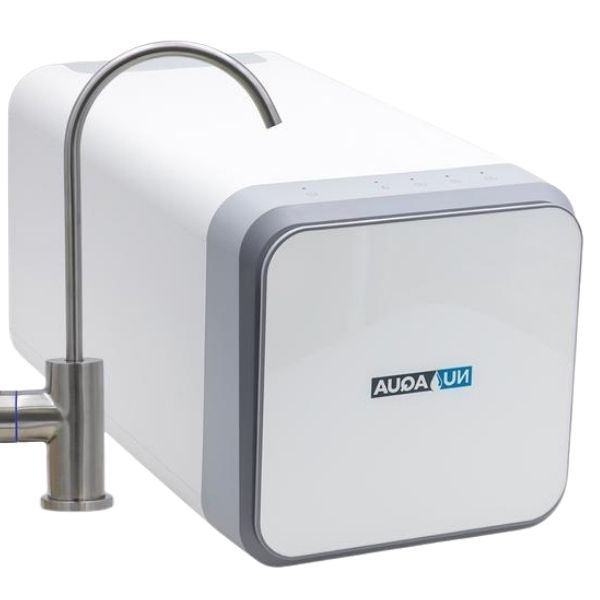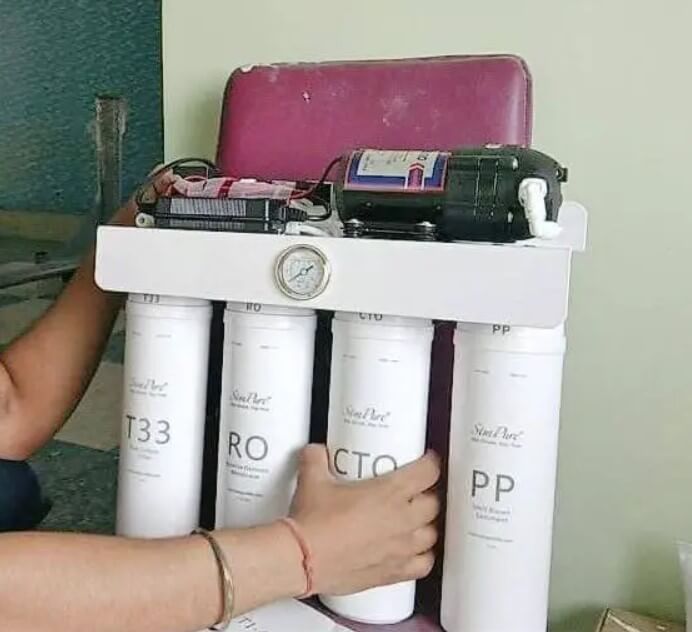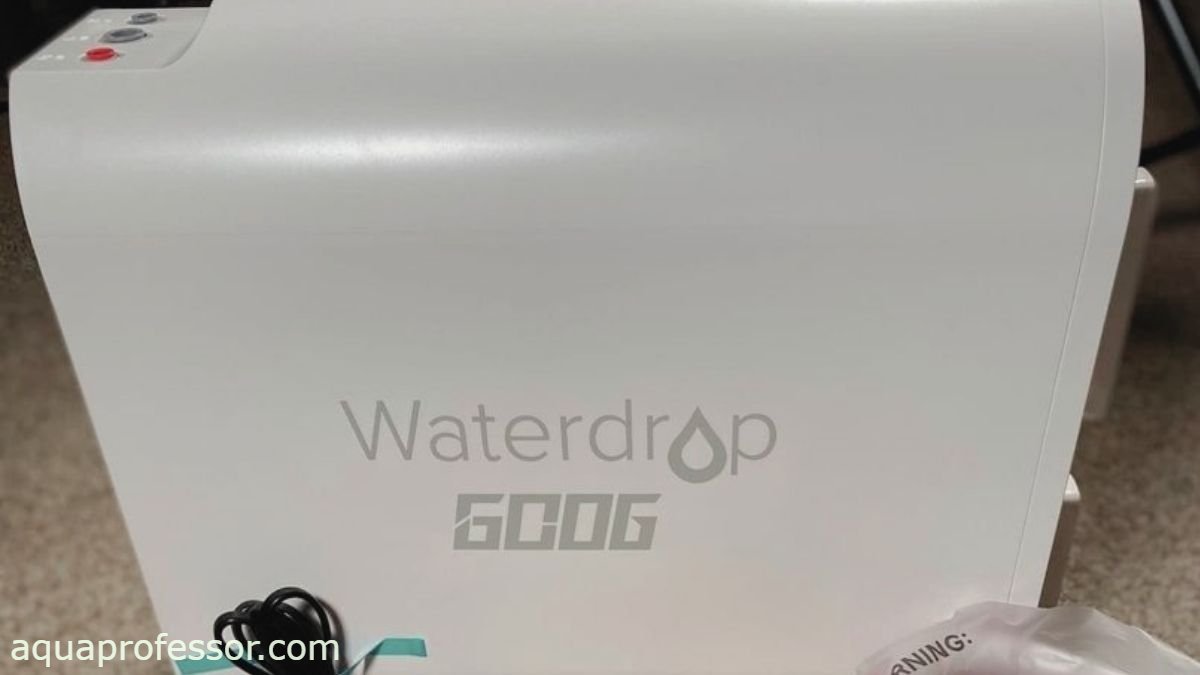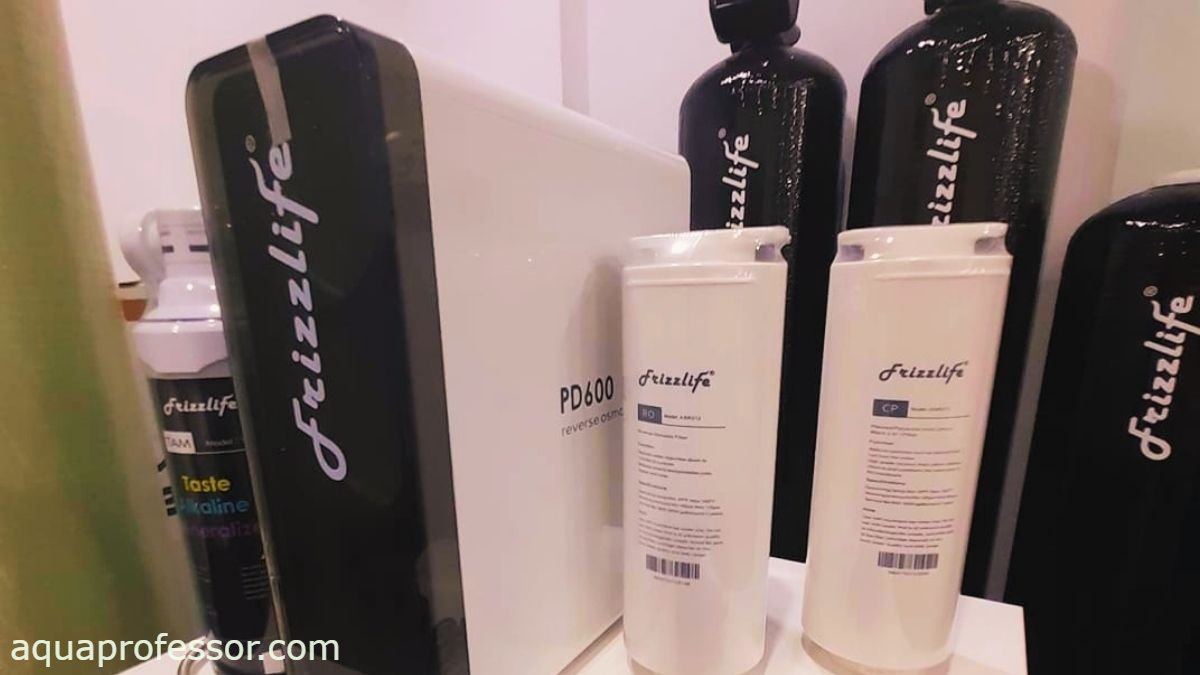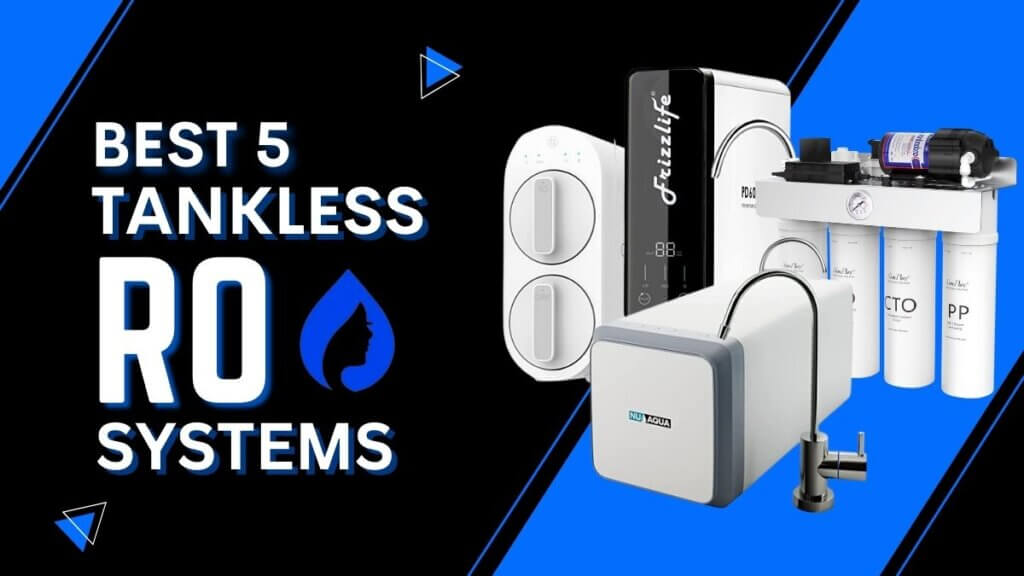
If you are looking for the best tankless reverse osmosis systems, you are in the right place.
Tankless reverse osmosis water filtration systems are easy to maintain and have amazing features like multistep filtration and intelligent faucet that make them the perfect choice for filtering your drinking water.
I spent 35+ hours researching and shortlisting so that you can use this list to compare and pick the options that best suit your needs.
5 Best Tankless Reverse Osmosis Systems: A Short Trailer
NU Aqua Tankless 600 GPD
- 600 GPD (Gallons Per Day)
- 2:1 purified drinking water to waste ratio
- Free 5-year warranty
- Membrane life span is 3 years
- Compact design
- 8 stages of filtration
Waterdrop G3
- 600 GPD
- 3:1 waste ratio
- 30-day money-back guarantee
- Intelligent faucet with indicator lights
- Smart TDS Monitoring Panel
- 7 Stages of the cross-filtration process
SimPure T1-400 RO3
- 5-Stage Tankless RO+UV Water Filter
- UV Light Eliminates Up To 99.99% of Harmful Microorganisms
- TDS Reduction Nearly Zero & 400 GPD High Flow Rate
- Filter Replacement Reminder & Twist-in Filter Design
- 1.5:1 Low Pure-to-Drain Ratio
- 2-year Warranty
Waterdrop G2 P600
- 600 GPD and saves up to 600% of water
- 1:1 drain ratio
- 1-year manufacturer + seller warranty
- Advanced composite filter technology
- Reduced leakage and Lead-free faucet
- 5 stage filtration
Frizzlife PD600-TAM3
- 600 GPD
- 1.5:1 drain ratio
- 3-year warranty for registered customers
- Remineralization & Alkalization of water.
- Smart LED Display
- 7 Stages of Filtration
This is a list of the market’s five best tankless reverse osmosis systems. Make your decision based on your needs and requirements.
I hope this article helps you check out the best options available on the market.
Here's How We Test Products At Aquaprofessor
- 5 Best Tankless Reverse Osmosis Systems: A Short Trailer
- Tankless RO Water Filter System Reviews: Comparison
- #1: NU Aqua Reviews: Tankless 600 GPD Filter
- #2 Waterdrop G3: Tankless Reverse Osmosis System
- #3 SimPure T1-400
- #4 Waterdrop G2 P600
- #5 Frizzlife Reverse Osmosis Review [PD600-TAM3]
- Tankless Reverse Osmosis Water Filter System Basics
- Tankless Reverse Osmosis System: Ultimate Buying Guide
- Are These Top Tankless RO Systems Worth It? (Pros & Cons)
- How To Maintain Tankless RO Systems? [What Pros Say]
- Best Tankless RO System: FAQs
Tankless RO Water Filter System Reviews: Comparison
*Best viewed on desktop
| RO systems | Easy To Install | Water Flow Rate | Easy to Maintain | Certifications |
|---|---|---|---|---|
| NU Aqua Tankless 600 GPD | Easy under sink installation | 600 GPD | Filters are easily replaced by twisting in and out of the place | _____ |
| Frizzlife PD600-TAM3 | Easy installation due to compact design | O.41 GPM (Gallons Per Minute) | Easy filter replacement with twist and click mechanism | NSF/ANSI 42 |
| Waterdrop G3 | Easy to install in a limited space | 0.42 GPM | Changing filters is easy, but meter settings reset automatically | NSF 58,372 |
| Waterdrop G2 P600 | Lightweight and easy to install with leakproof connections | 0.42 GPM | Filter replacement is easy, but beware of leakages | NSF 58,372 |
| SimPure T1-400 | Compact size allows easy installation under the sink | 0.27 GPM | Easy as a smart LED display alerts when it’s time to replace the filters. | Certified by SGS against NSF standards |
#1: NU Aqua Reviews: Tankless 600 GPD Filter
Pros
- It has a highly efficient performance.
- 1/4th the size of a traditional RO system
- Easily changeable filters.
Cons
- Quite expensive
- Not NSF certified
The NU Aqua Efficiency Series, a modern and compact tankless reverse osmosis system, is the ideal tankless RO system if you are concerned with water quality. It gets rid of 99% of contaminants by passing the water through 4 stages of filtration.
NU Aqua Tankless 600 GPD: Why Do I Recommend?
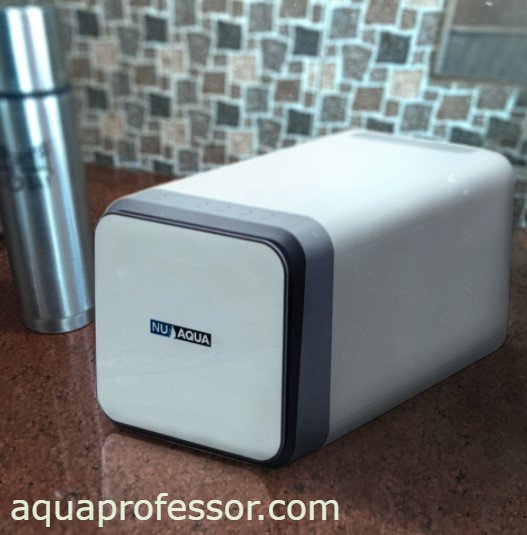
Also Read: What's Wrong With Brita Filters [Reasons with Solutions!]
NU Aqua Tankless 600 GPD: System Features & Benefits
The water filtration system’s four stages of filtration remove various potential contaminants, including VOCs, chlorine, rust, and suspended sediment particles. The process of replacing the filters is easy.
The PP/CB filter will last six months, the GAC filter will last one year, and the RO membrane will last 36 months.
NU Aqua Tankless 600 GPD: Who is it Best For?
The NU Aqua Efficiency Series is the best system for you if you have a flexible budget and if your goal is to find a system that saves space and reduces wastewater.
#2 Waterdrop G3: Tankless Reverse Osmosis System
Pros
- It comes with an intelligent faucet and filter light
- Low-cost replacements
- Fast water flow
- Quick, easy installation
Cons
- If it doesn’t remineralize your water.
- Very expensive.
The Waterdrop G3, at 5.68 inches wide, is a slim, space-saving reverse osmosis water filtration system, ideal for under-sink locations with limited space. It is NSF 58 & 372 certified for build quality and lead reduction.

Waterdrop G3 Exclusive Discount
Save $55 on official Site
Waterdrop G3: Best Under-Sink Tankless Reverse Osmosis System
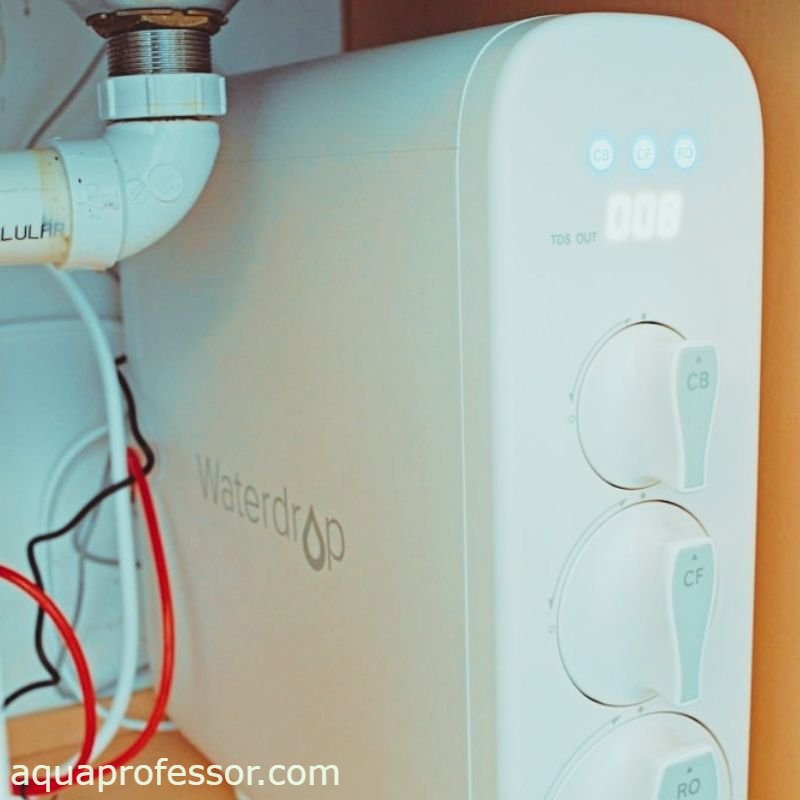
Also Read: Fleck Iron Pro 2 Review
Waterdrop G3 : System Features & Benefits
The Waterdrop G3 is one of the best-designed tankless RO systems available, with clever and convenient features that make it stand out.
It has a faucet with a change filter light and a helpful reminder indicating when you will need to replace your filters.
A TDS monitor lets you know how many contaminants were removed from your water, informing you that the filters are doing their job. The G3 water purifier has three filter stages:
The water filter comprises a polypropylene (PP) cotton and carbon block filter that removes sediment, chlorine, and lead; an RO filter that removes Total Dissolved Solids (TDS); and a post-activated carbon filter that removes any lingering contaminants.
The G3 can be easily installed in 30 minutes. It can be put into holiday mode when you’re away, so you don’t have to worry about filter issues during this time.
The system has a 2:1 wastewater to pure water production ratio, making it far more energy-saving than most RO systems.
Why You Should Consider Waterdrop G3?
If you enjoy the convenience of smart features and add-ons, you’ll appreciate the Waterdrop G3, which has a built-in monitor to notify you when filters need to be changed.
#3 SimPure T1-400
Pros
- The compact size allows for easy installation under the sink.
- It comes with a water pressure gauge to remind you when it’s time to change the filter.
- The system has been certified by SGS against NSF standards, ensuring its effectiveness and reliability.
- The tankless design provides continuous clean water without needing a storage tank.
Cons
- Doesn’t have NSF Certifications
The SimPure T1-400 RO system is a tankless reverse osmosis system that filters up to 400 gallons of water daily for a larger home or commercial use. This tankless RO water filtration system uses its own unique filtration technology, and TDS reduction can be close to zero.
SimPure T1-400 RO + UV Filter: Is It Worth It?
In Feb 2023, an Ohio train derailment increased the risk of a cancer-causing chemical: vinyl chloride in water.
SimPure T1-400 RO can remove vinyl chloride, and its UV filter can remove up to 99.99% of harmful bacteria like E.coli from drinking water.
SimPure Tankless RO: System Features & Benefits
The SimPure Tankless RO system features a compact design that saves space and offers a continuous supply of purified water without needing a storage tank.
The system also boasts quick and easy installation, low maintenance, and a water pressure gauge that alerts users when it’s time to replace the filters.
With the SimPure Tankless RO system, users can enjoy a reliable and cost-effective solution for their daily water needs.
SimPure Under-Sink: Who Is It Best For?
The SimPure Under-Sink system is suitable for homeowners who prioritize convenience, space-saving, and reliable water filtration.
It is particularly well-suited for those with limited space who want a compact filtration system installed easily under their sink.
#4 Waterdrop G2 P600
Pros
- Easy to install and maintain
- Fast water flow rate
- Highly effective and space-saving
- Removes 99% of contaminants
- It comes in a sleek design
- Quiet operation
- Lightweight and compact
- Enhances the taste of the water
- One-year manufacturer warranty
Cons
- Expensive
The Waterdrop G2 is a powerful tankless under-the-sink RO system that can save space and is easy to install, maintain, and use. It saves a lot of space while being highly effective at removing contaminants, has a high-speed water flow rate of 400 gallons per day, and is ideal for small families but can also sustain small businesses.
How Is Waterdrop G2 P600 An Excellent Pick?
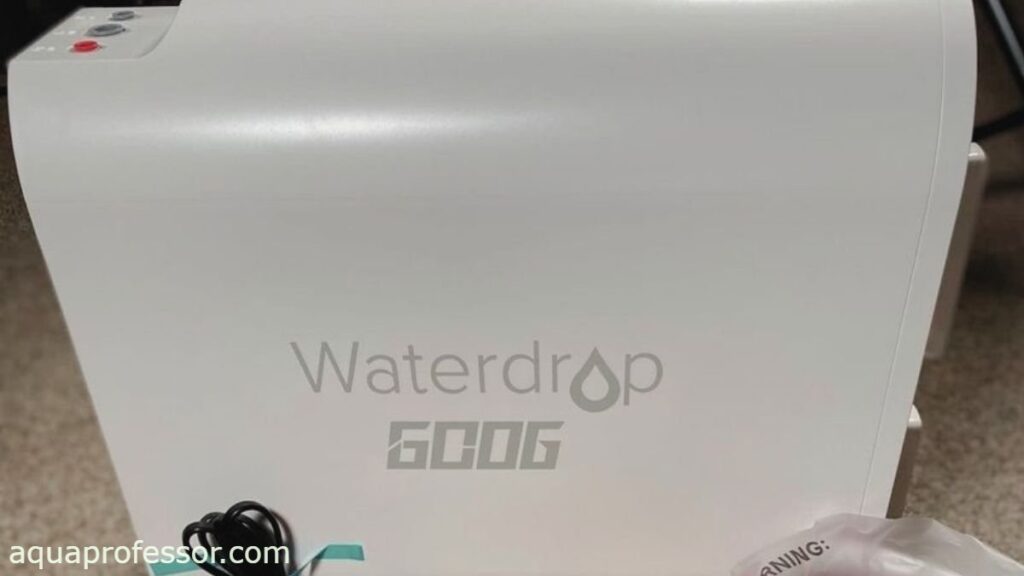
Waterdrop G2 P600: System Features & Benefits
The Waterdrop G2 is highly efficient since it creates one gallon of wastewater for each gallon of pure water. The built-in pump increases water pressure, reducing waste and enhancing efficiency.
The CF pre-sediment and carbon block filter should be replaced once every year. The MRO composite filter has to be replaced once in two years.
You can add a level of protection with multiple warranties. The MRO (membrane, reverse osmosis) filter warranty lasts two years, and the CF (carbon, fiberglass) filter warranty lasts one year.
The built-in pump increases water pressure, reducing waste and enhancing efficiency.
The CF pre-sediment and carbon block filter should be replaced once every year. The MRO composite filter has to be replaced once in two years.
Reduced Waste, Enhanced Efficiency
The Waterdrop G2 is highly efficient since it creates one gallon of wastewater for each gallon of pure water.
Waterdrop G2 P600: Who It’s Best For?
It’s best for people looking for tankless under-the-sink RO systems to support small to mid-sized families and small businesses.
#5 Frizzlife Reverse Osmosis Review [PD600-TAM3]
Pros
- Remineralizes water
- A fast flow rate of 600 GPD
- Efficient, water-saving performance
Cons
- Included faucet is a little flimsy
- Made in China
Frizzlife’s Tankless Reverse Osmosis System is a three-stage no-tank reverse osmosis filter that removes Total Dissolved Solids (TDS) and alkalizes water, allowing for the best taste. It has an impressively high flow rate of 600 gallons per day, with a drain ratio of 1.5:1.

Frizzlife Discount
Save $70 on official site
Is Frizzlife PD600-TAM3 The Best Tankless RO System With Remineralization?
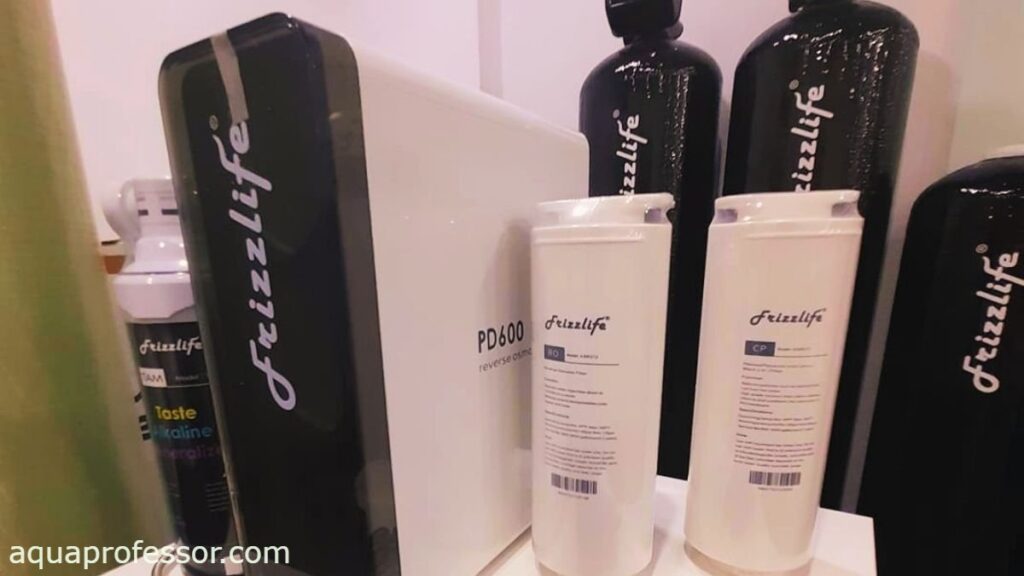
Also Read: Sterling Water Softener Reviews [2024]
Frizzlife PD600-TAM3 : System Features & Benefits
The Frizzlife Tankless RO System uses seven filtration processes: a sediment filter, a carbon block filter, a reverse-osmosis membrane, a remineralization filter, and a weak alkaline filter, resulting in almost 100% TDS-free alkalized water.
This advanced reverse osmosis system has a low drain ratio, and it can save as much as 450% more water than a traditional under-sink filtration system.
The unit also requires less installation effort, and changing the filter is as simple as removing the old filter and clicking the new one into place. Unlike other units, the Frizzlife reintroduces calcium and magnesium, increasing pH levels to improve health properties in the water.
Save 450% More Water
This advanced reverse osmosis system has a low drain ratio, and it can save as much as 450% more water than a traditional under-sink filtration system.
Who Does Frizzlife Tankless RO System Serve The Best?
If you prefer to install an instant-use reverse osmosis filtration system, the Frizzlife Tankless RO System is the answer.
Tankless Reverse Osmosis Water Filter System Basics
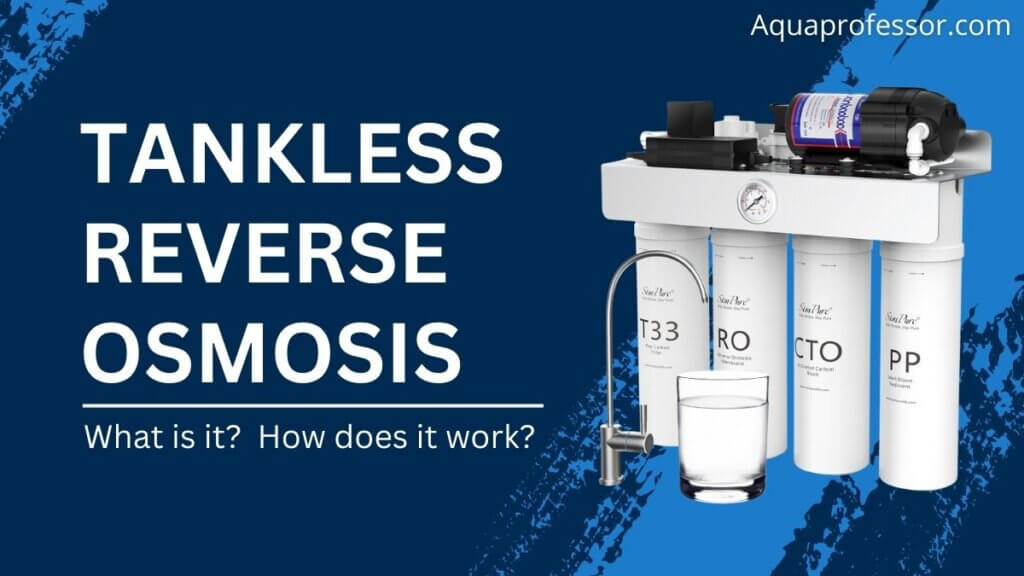
As the name suggests, tankless RO models for water filtration lack a tank to store purified water.
A storage tank in a water filter is used to hold the clean water produced by the filter until consumed.
So, you usually have to switch on a water filter, wait for the tank to fill, and switch it off once full.
Utilize the water, and when the tank empties, you switch on the filter again to run its filter process and fill the tank.
But tankless RO filters skip this storage cycle and provide freshly filtered water whenever needed. You must ensure the filter’s electricity supply is on during the process.
Turn on the faucet and Voila! The clean water starts flowing out almost immediately.
So, unlike traditional RO filters, tankless systems require electricity every time you want them to operate to supply purified water.
Tankless RO filters don’t have a tank, so they are much more sleek and compact. That doesn’t mean that they fall behind in performance.
The working of tankless RO filters is also based on multiple filtration stages. Dirty water is forced to pass through different filter membranes, and in turn, the impurities are left behind.
Besides the RO filter stage, other stages may include pre-filter, activated carbon or carbon-block filter, UV light filter, remineralization, and pH balance tanks.
Sediment pre-filters are a must first stage of any filter as they increase the lifespan of successive filters.
Pre-filters trap big impurities like dust, gravel, fibers, debris, etc. A carbon filter is specialized to trap odors, organic solvents, microorganisms, and chemicals, resulting in great-tasting water.
A minimum of 3 filter stages are always incorporated into all water purifiers for good water quality.
Electricity is used to produce enough pressure for water to pass through all filter stages smoothly, all the way upto the faucet.
Tankless Reverse Osmosis System: Ultimate Buying Guide
Environment-Friendly Materials
The use of food-grade or environment-friendly materials in water filters is advisable.
Pay Attention To Unique Features
There are three-stage, four-stage, and five-stage reverse osmosis water filters available online.
The more filtration stages it has, the better the water quality gets. Some have a single filter that can use up to five water filtration stages.
How Easy Is The Installation
When installing reverse osmosis filters, tankless filters are convenient choices. The consumer can install them, and power is rarely an issue. The faucet will require professional work.
How Often Do The Filters Need Changing
RO tankless water filters require that you change the filter after six months. You can also buy low-maintenance filters such as activated carbon filters.
Are These Top Tankless RO Systems Worth It? (Pros & Cons)
Now that you believe a tankless RO system can purify dirty water into clean drinking water, let’s find out if it is worth it!
Pros
- Saves 50-75% of space
- Unlimited clean water delivery consistently
- Higher efficiency
- Easier Installation
- Easy to clean with less exposed parts
- Added features like LED indicators, TDS meters, and innovative faucets
Cons
- Costlier
- Requires electricity every time to fetch water
- Low pressure and slower output
- Limited custom options
- Don’t work well with other devices like ice and coffee makers
We have already tested both with and without tank RO water filtration units. We have analyzed and witnessed every aspect of their work to present our verdict before you.
Saves Space
If you consider space a factor, then the Tankless system has the upper hand. It takes 50-75% less space than the traditional RO filters (almost ⅓ of the standard size).
It gives the manufacturer the freedom to create compact and elegant designs. They are perfect for both under-sink and countertop installation.
Ease of Installation and Maintenance
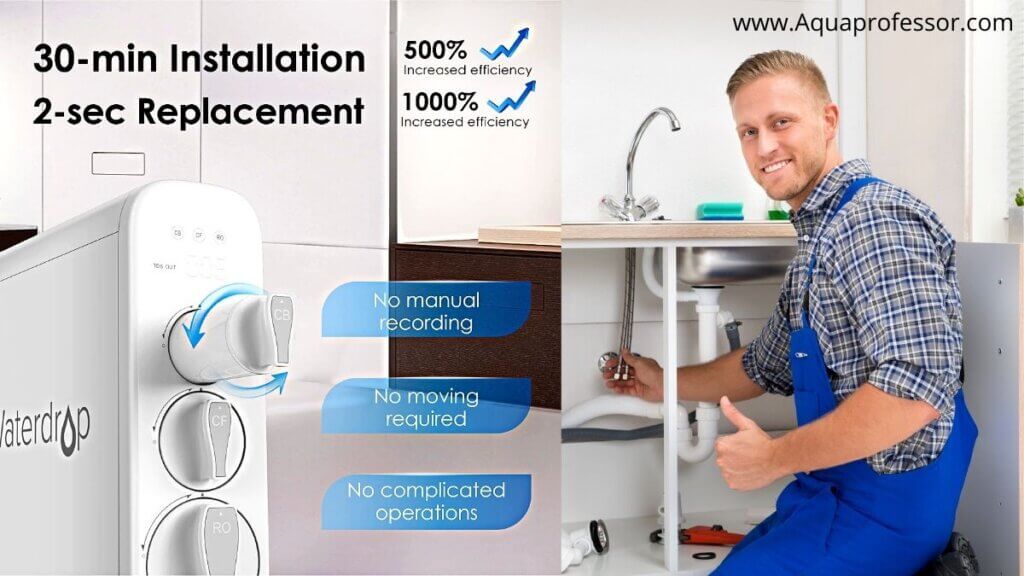
When it comes to which system provides your better convenience in the installation process and conducting maintenance, the Tankless system wins the argument. It’s because of the way they are built.
Note that all filters need cleaning, both inside and outside. In traditional RO water filtration systems, there are many exposed connections and protruding tanks.
Some nooks and corners are easily overseen and remain uncleaned. Plus, you may observe a settled-down muddy layer at the bottom of storage tanks after some time, which needs to be washed out.
Tankless systems have an easy twist-out-twist-in mechanism to replace old saturated filters with new ones.
The one-piece box-shaped filter is super easy to clean precisely from the outside. There is no tank, so you don’t have to worry about the sediment layer or filter holding tanks.
Smart Features
The absence of a tank in a tankless filter allowed product designers and manufacturers to include additional features in the system.
These features include a built-in TDS (Total Dissolved Solids) meter to calculate impurity levels, green-yellow-red LED indicator lights on the filters to notify the working status of the filter and a dedicated faucet.
Fresh On-Demand Water Supply
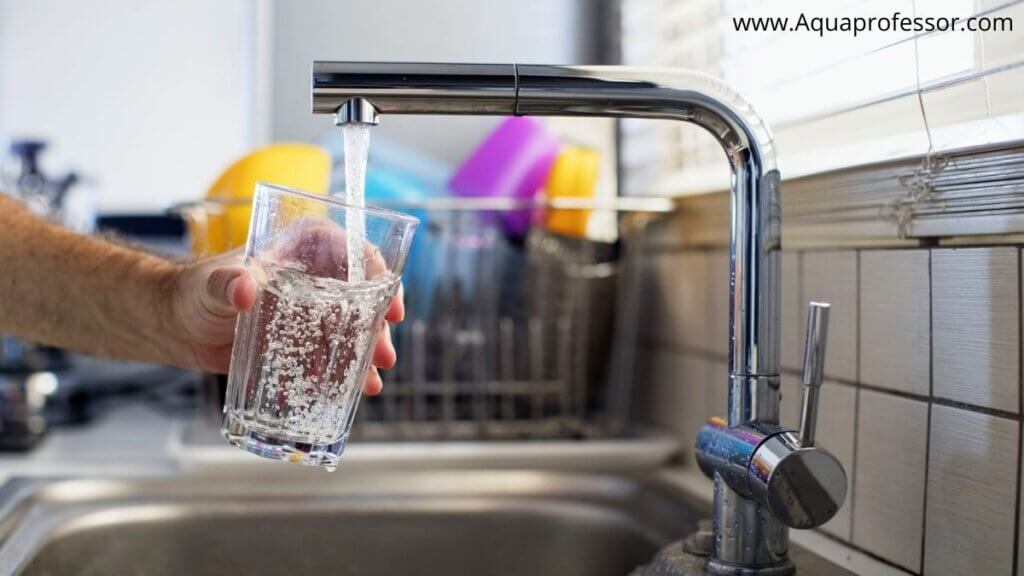
Water sitting for a long time or freshly extracted clean water, which is better?
Even you can answer this question very well. Let’s face it; stagnant water does gain some smell and altered taste in tank-based units.
On the other hand, Tankless RO systems only draw water to clean when commanded. Thus, fetching you freshly extracted clean water for drinking.
Economical
You might wonder how a costlier RO filter will be economical for you.
Let us explain: Keep in mind that what seems expensive initially might benefit you in the long run. The total cost is calculated by considering the cost of purchasing, installation, and maintenance.
Plus, in this design, multiple filter stages have been accommodated into a single cartridge.
That means you would have to buy less number of filters which will need replacement after an extended period. So, reduced expenditure in the long run as well.
Time
Our fast-paced life has created a need for quick services. Instant food, instant messages, instant coffee, instant travel, and instant water supply! A race against time.
Unfortunately, tankless RO systems are a bit behind in this aspect.
Freshly filtered water or stored clean water that is delivered more quickly: the choice is yours.
If a few-second delay works for you, go for it! But remember that this low-pressure water supply won’t yield satisfactory results when connected with ice makers or coffee makers.
Customization
There is a trend to customize everything according to your requirement nowadays—even water filters.
You can estimate your water quality and choose only those filter units that fulfill your purpose. But, tankless RO filters are not very customizable.
Its closed compact design can neither be further connected to more tanks or filters nor can one be removed from within.
You have to use the unit as it is without making any changes. So, think this through before coming to any decisions.
How To Maintain Tankless RO Systems? [What Pros Say]
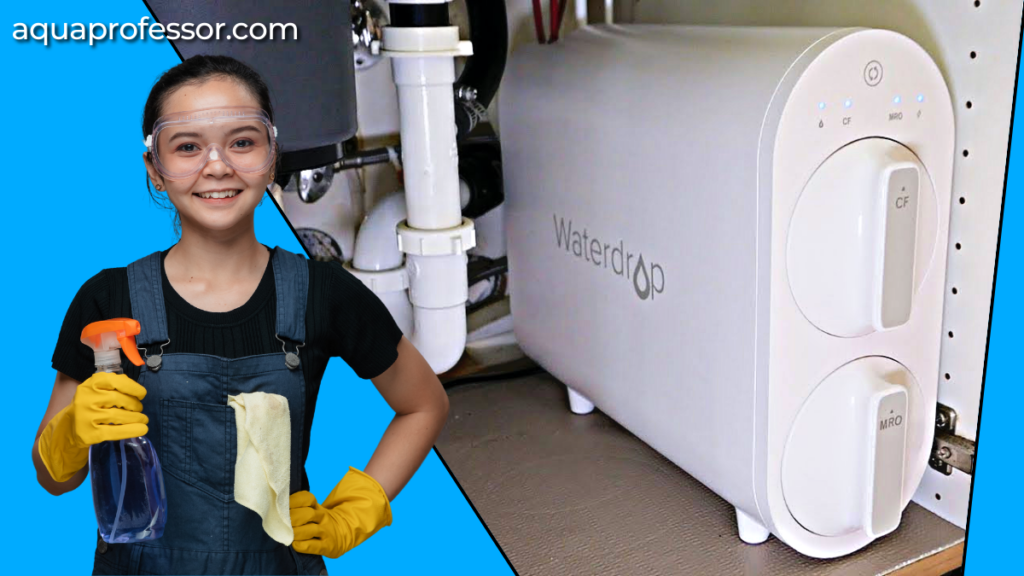
If you are going for a Tankless RO system for your home kitchen, don’t let your well-researched and thoughtful decision go in vain.
Ensure you maintain the filter unit properly to utilize it fully and get your money’s worth.
Like any electronic device or appliance, tankless RO systems also demand a little attention.
After talking to water filter professionals and reading expert articles, we know how one can maintain a tankless RO system properly over the years.
Here’s what you need to know:
As discussed earlier, tankless RO systems are much easier to maintain than other filters. Maintenance, in simple words, means keeping a device clean and efficient at all times.
Inside cleaning includes replacing filters or washing out dirt stuck on the inner surface of the cartridge compartment. How often a filter has to be replaced depends on your family size and water usage.
The more you use an appliance, the sooner it wears out. Wearing out of filters means that the filters have clogged with impurities over time.
It is also known as saturation which can either be indicated by smart LED lights if you have an advanced model or dirty water in your glass.
Tankless systems often have horizontal twists and click cartridges for easy extraction and insertion.
Some filters might also need water flush before insertion to open up the new pores. Have a good water day!
Best Tankless RO System: FAQs
How Does a Reverse Osmosis Water Filtration System Work?
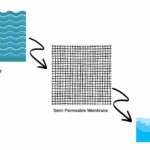
It is helpful to define the scientific term osmosis to understand water filtration.
Osmosis is the diffusion of a solvent (such as water) through a semipermeable membrane (such as a living cell) into a solution of higher solute concentration.
The concept behind a reverse osmosis filter system is the opposite of osmosis.
Instead of creating more concentrated water, water filters help break down the concentration level and provide water with less concentration.
It is done by forcing the water through filters and pressuring it to eliminate the contaminants commonly present in tap water from public water supply or private wells.
Tank VS Tankless RO Water Purifier – Which is Better?
There are two main types of home reverse osmosis (RO) water purifiers: those with a drinking water storage tank and those that do not.
Drink RO water purifier with tank; however, if you use a tankless RO water purifier, you do not need to wait for the drinking water container to fill before using the purified water.
As a higher standard of living brings an increased demand for purified water, filter dealers have launched an upgraded Reverse Osmosis (RO) water purifier with high storage capacity—and no tank.
The main appeal of this drinking water filtration system is that it eliminates the pressure container, which reduces the amount of space needed under the sink while also removing any contamination caused by the storage tank.
How much wastewater do reverse osmosis systems produce?
Although reverse osmosis is a popular process for purifying water, it wastes a significant amount of water.
The waste ratio of a reverse osmosis system depends on each model.
In general, though, three gallons of wastewater are generated for every one gallon of clean water produced by a reverse osmosis system.
Will RO filters remove minerals from my water?
Water filtration systems remove a range of compounds from water, including unhealthy minerals, but some systems filter the water while retaining certain healthy minerals.
Water filters containing activated carbon and ceramic don’t remove minerals from tap water.
Water filtration systems that use carbon filters will remove chlorine, VOCs, THMs, and other organic contaminants but not minerals, salts, heavy metals, etc.
In some domestic water filtration applications, carbon filters are paired with ceramic filters to make up for some shortcomings of carbon filtration (e.g., carbon is not enough to remove viruses and other pathogens from your tap water; thus, ceramic is used).
Which is better for you, distilled or reverse osmosis water?
Distillation removes all contaminants, minerals, and pollutants. Reverse osmosis water removes minerals, bacteria, and viruses while pollutants remain.
Reverse osmosis is the best choice for households that need long-term water purification. Bottled distilled water is fine to drink, as long as it’s unopened.
Many people prefer whole-house water filtration systems, NSF-certified or MWF filters.
How much does a tankless reverse osmosis system cost?
The average price range varies from $300 – $800. That’s just the initial purchasing cost. The installation and maintenance may cost you $50 – $150 annually.
This cost varies depending upon the type of filter to be replaced, its size, and the number of filtration stages.
Whole house RO systems do not come in tankless designs. Tankless RO water filter systems are only available as Point-Of-Use (POU) models like under-sink or countertop filters.
Conclusion
Best Tankless Reverse Osmosis Systems help you get fresh water without any pollutants. Reverse Osmosis systems that store water in a tank are also effective but may add pollutants to the water.
As a result, it would be wise to buy any of the top tankless reverse osmosis systems we recommend according to your needs.
These systems have various filtration features and faucets with a built-in notification LED.
Adarsh is a Health & Nutrition Sciences graduate with expertise in environmental health. He is associated with ventures like Glacier Fresh Filter and Simpure Filter Systems. Through Aqua Professor, he intends to provide helpful information to every home to help them make smarter decisions.

